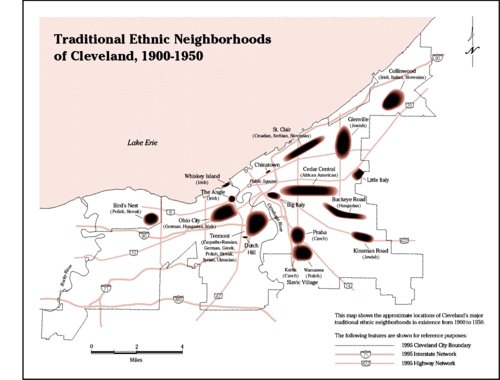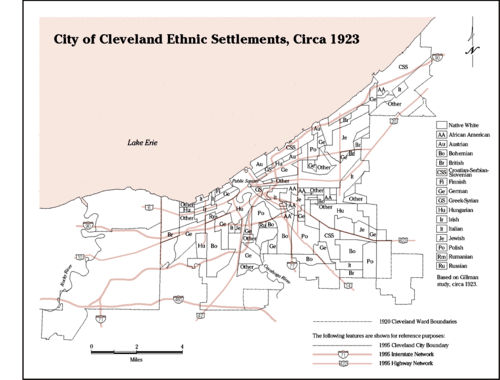Ethnic Settlements in Cleveland
Ethnic Settlements in Cleveland
In 1870, there were only approximately 35 Italians in Cleveland, which amounted to a mere .03% of the Cleveland population. During the last two decades of the nineteenth century, Italian immigration to Cleveland contined to steadily increase and by the turn of the century, 3,065 Italians resided in Cleveland. The height of Italian migration to the United States and Cleveland happened during the 1920s and 1930s. For example, in 1921, over 220,000 Italians emigrated to the United States. Census results show that 18,730 Italians resided in Cleveland in 1920 and 23,524 in 1930.
Why Cleveland?
After disembarking in New York, Italians followed a "migrant chain" to Cleveland. According to Gene Veronesi in Italian Americans and Their Communities of Cleveland, the single overriding factor that brought Italians to Cleveland was local ties. An estimated three-fourths of Italians migrating to Cleveland followed a well-traveled course stretching from southern Italy and Sicily to Cleveland. Many Italians traveling to Cleveland were from the same village and district (Veronesi, 174). In fact, according to Josef Barton in Peasants and Strangers, among Italian places of origin, four districts - Patti and Palermo, in Siciy, and Benevento and Campobasso, in the Abruzzi - composed about 70% of the Italians coming to Cleveland.
Arriving in Cleveland
In 1913, Cleveland's Department of Public Safety established the Bureau of Immigration to address immigrant arrival and assist with problems confronting foreigners. For example, in 1914 over half the trains carrying foreigners arrived in Cleveland at night without a set schedule. Members of the Immigrant Bureau were assigned to meet the arriving trains and direct passengers to friends or relatives waiting. Measures were also taken to discourage cabmen from overcharging immigrants. (Veronesi, 182). Before departing the depot, immigrants were also given three manuals "Immigrant's Guide," "Citizen's Manual for Cleveland" and "Everyday English for Every Coming American." These pamphlets assited in "Americanizing" and "Clevelandizing" the new arrivals by guiding in practical matters such as health care, laws, money, responsibilities and opportunities for citizenship.

